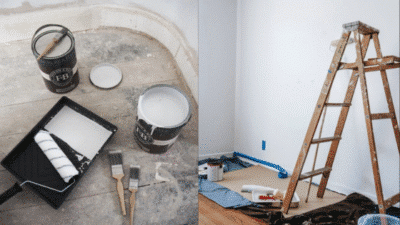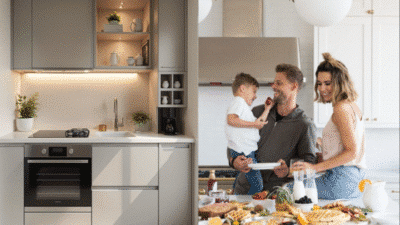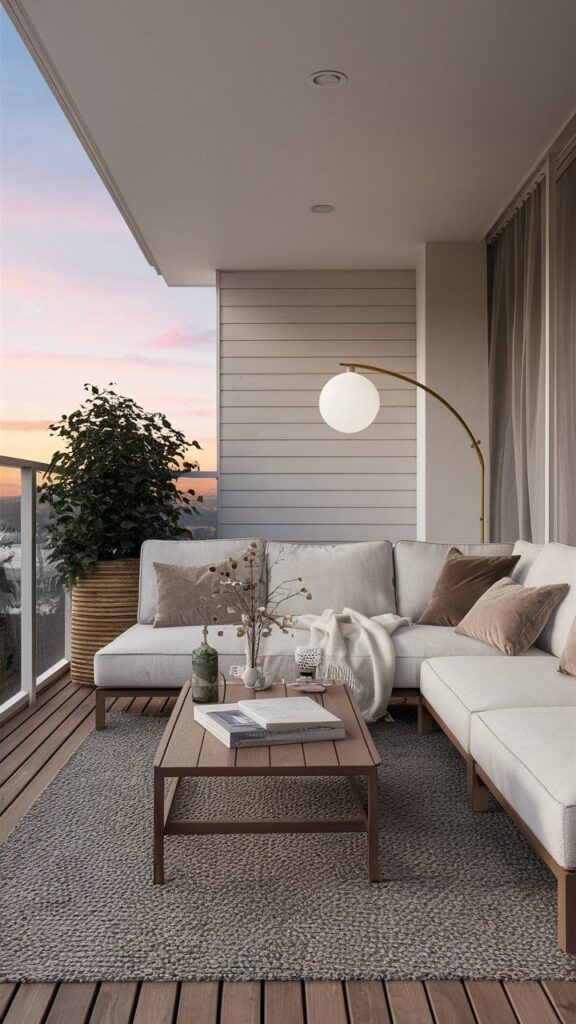
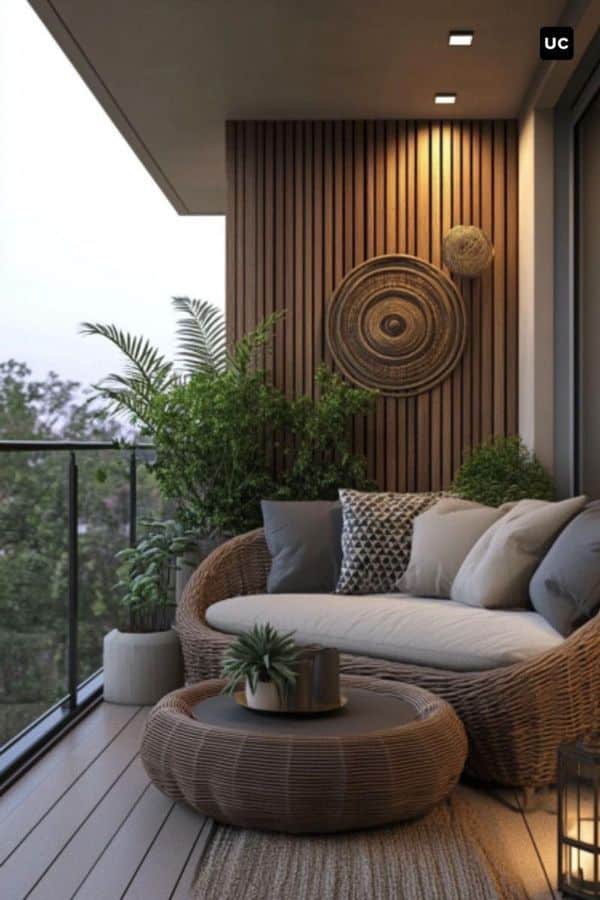
Balconies and terraces are valuable outdoor spaces that can be transformed into cozy and stylish areas with the right ideas. Simple changes like choosing the right furniture, adding plants, and using creative lighting can make these spaces both functional and inviting.
Many people overlook the potential of their balconies or terraces because of limited space or uncertainty about design. With practical choices and thoughtful decor, anyone can turn these areas into relaxing spots for dining, entertaining, or simply enjoying fresh air.
This post will explore easy and effective styling tips that help make the most out of balcony and terrace spaces. Readers will find ideas suited for different sizes and uses, making it easier to create a personalized outdoor area.
Key Takeways
- Selecting appropriate furniture improves comfort and use of space.
- Adding plants and lighting enhances atmosphere and style.
- Privacy and decor choices increase enjoyment and functionality.
Balcony and Terrace Design Fundamentals
Designing a balcony or terrace requires careful thought about space, light, and materials. These key factors help create a comfortable and lasting outdoor area.
Maximizing Space Efficiency
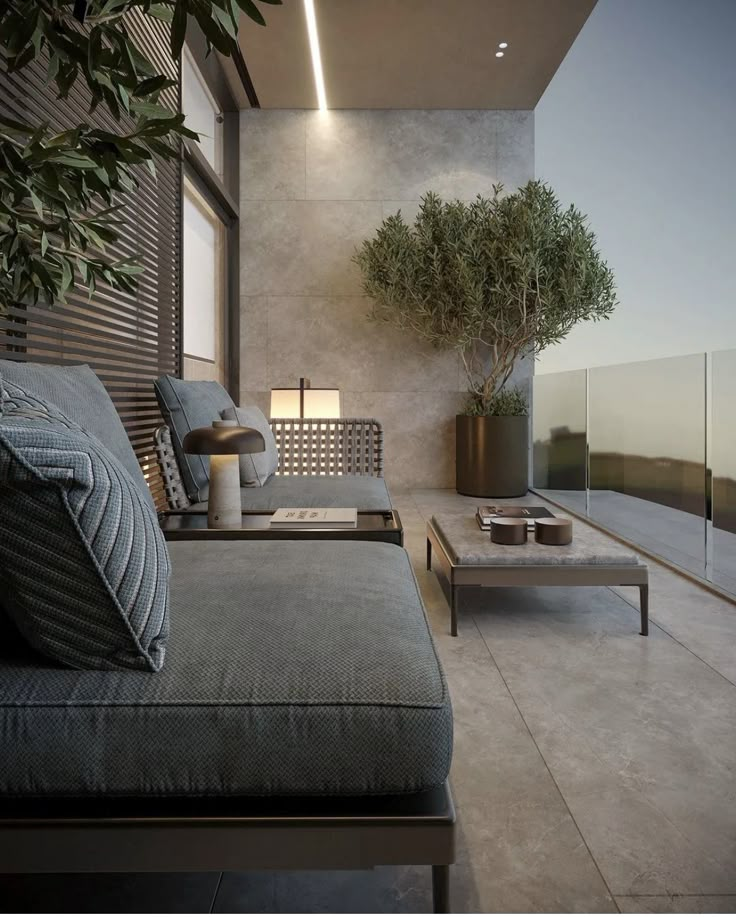
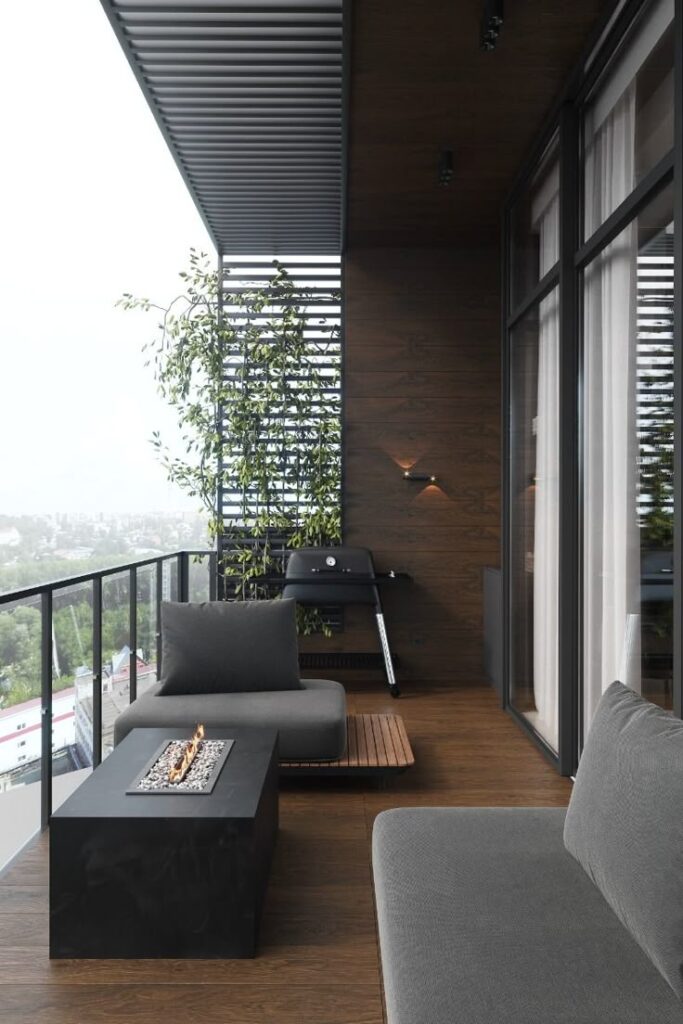
Small balconies need smart layouts to feel open and useful. Using foldable or stackable furniture saves room. For example, a fold-down table can be tucked away when not in use.
Vertical space matters too. Shelves, hanging planters, and wall-mounted storage keep floors clear. This approach allows for plants or decorations without crowding.
Choosing multi-purpose furniture is helpful. A bench with storage inside can hold cushions or gardening tools. This keeps the area neat and functional.
Understanding Sunlight and Shade
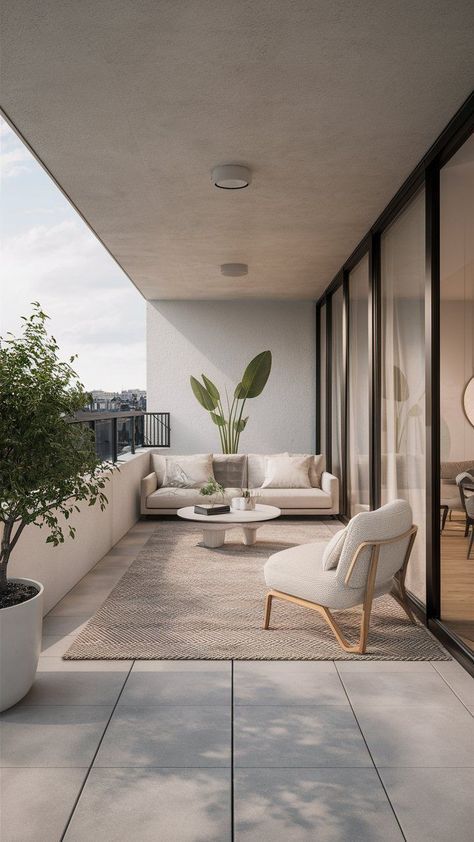
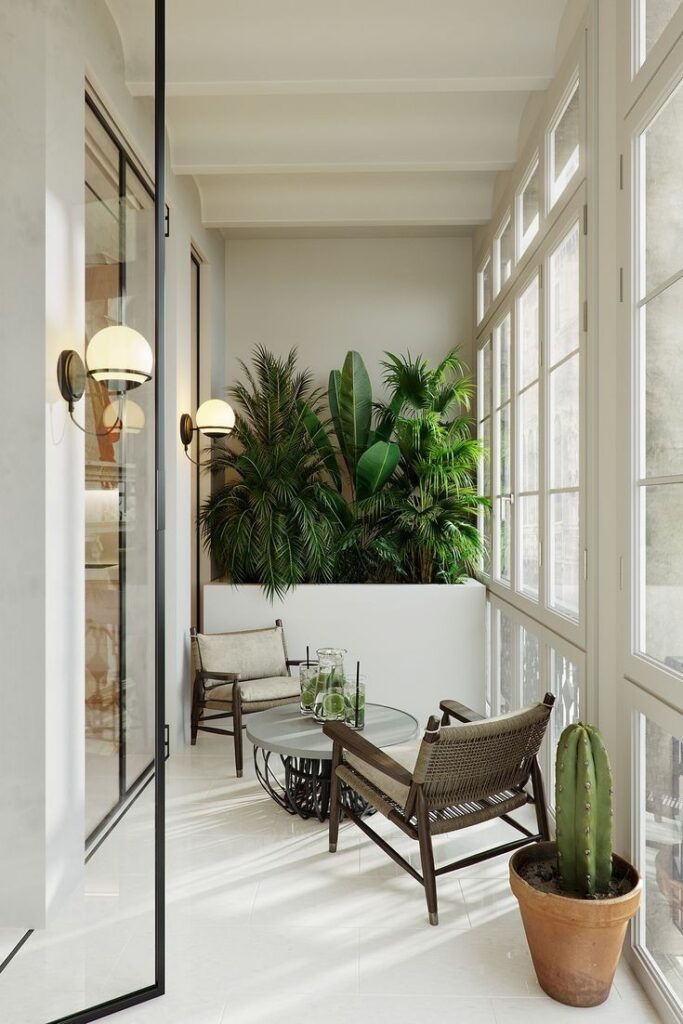
Knowing how much sun a balcony gets is important. South-facing balconies receive more sunlight, best for sun-loving plants and lounging chairs. North-facing balconies get less direct light, so shade-tolerant plants work better.
Shade options include umbrellas, shade sails, or retractable awnings. These protect against harsh sun and rain. Position seating areas where sun exposure is most comfortable during different times of the day.
Plant placement also affects shade. Taller plants can block midday sun, helping to cool the space naturally.
Choosing Durable Outdoor Materials
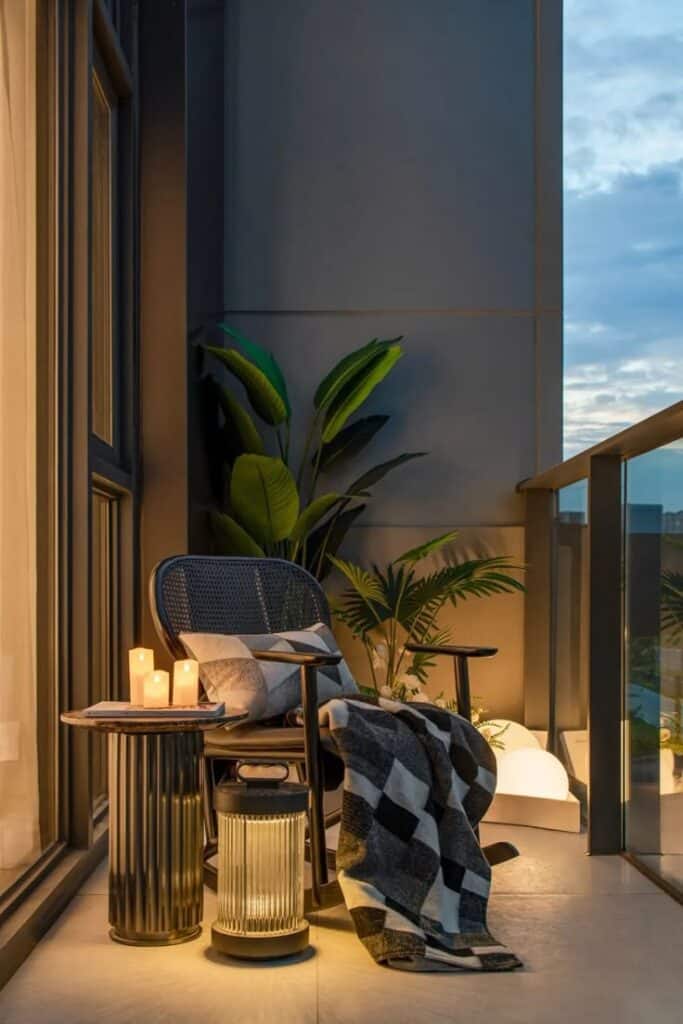
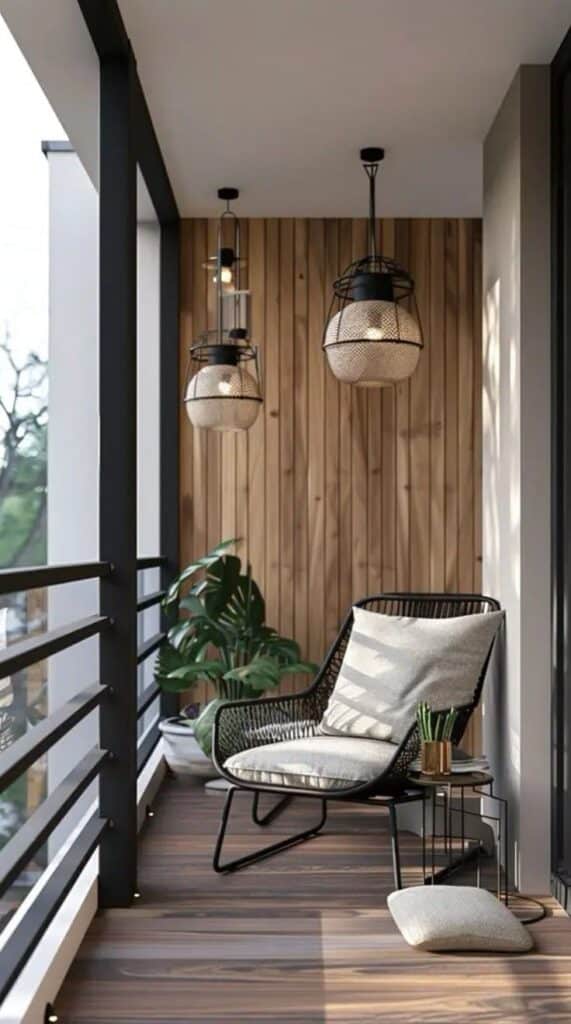
Outdoor furniture and decorations must withstand weather. Materials like teak, metal with rust protection, and all-weather wicker last longer.
Fabrics should be water-resistant and fade-proof. Look for cushions with covers made from synthetic fibers like polyester or acrylic.
Flooring options include treated wood, composite decking, or stone tiles. These resist moisture and temperature changes, keeping safety and appearance intact.
Regular cleaning and maintenance extend the life of all materials. Using covers during harsh weather also helps protect furniture and plants.
Furniture Selection for Small Spaces
Choosing the right furniture for a balcony or terrace is key when space is limited. The focus is on options that save space without sacrificing comfort or style. Pieces need to fit well and work efficiently.
Compact Seating Solutions
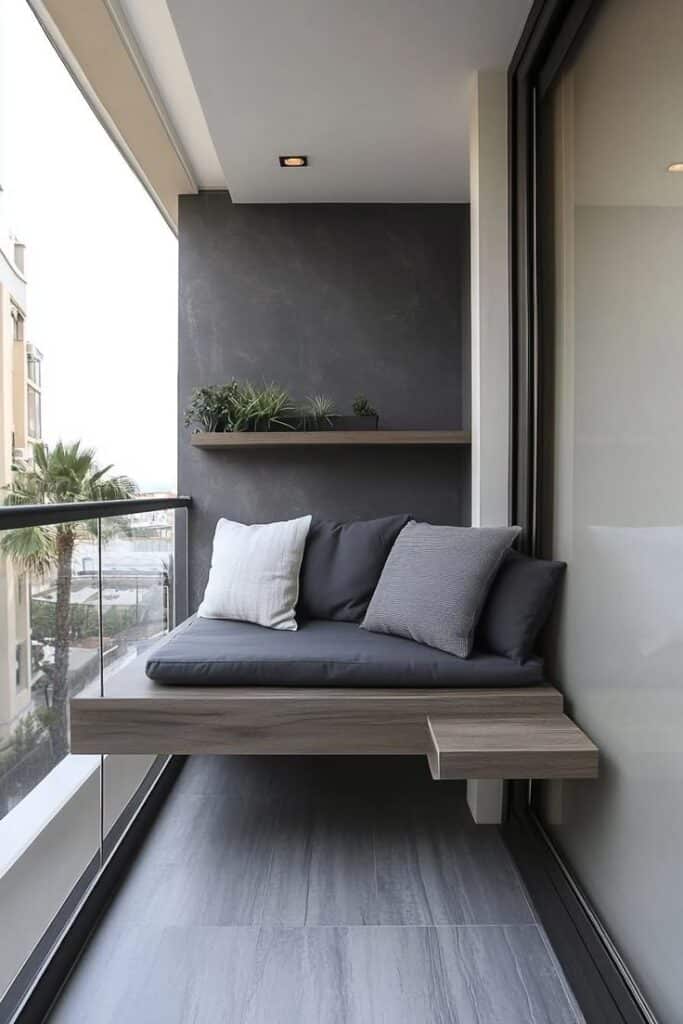
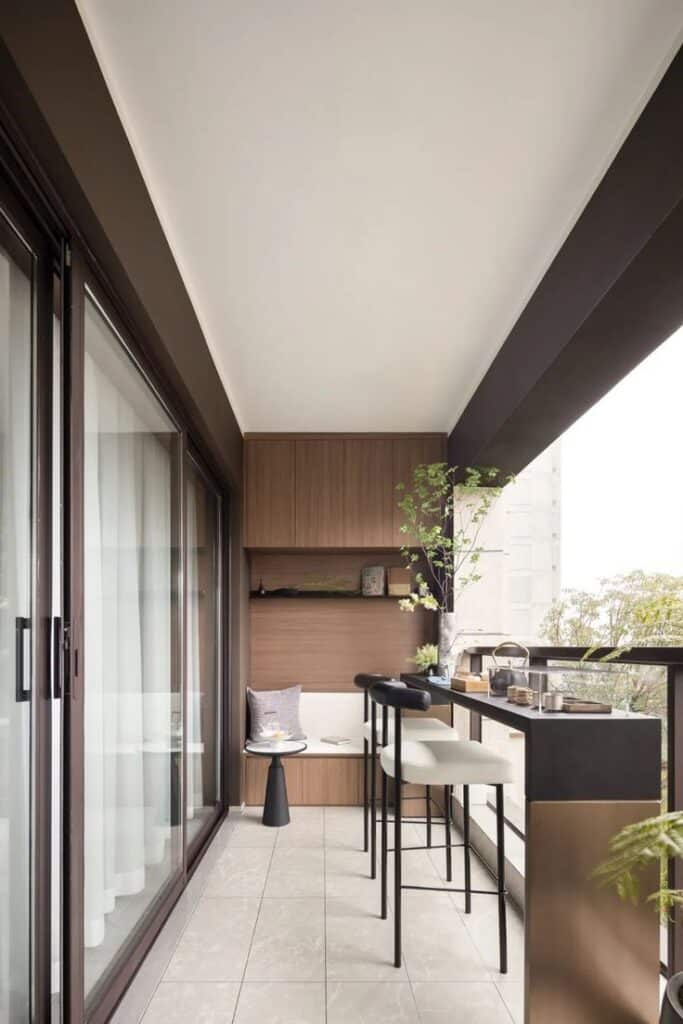
Small areas benefit from compact seating like foldable chairs or stackable stools. These options are easy to move and store when not in use.
Benches with storage underneath can also provide extra seating without cluttering the area. Slim-profile chairs with narrow arms save room but still offer comfort.
Using cushions or poufs can add flexible seating that can be tucked away. Metal or plastic materials often take up less visual space than bulky wooden furniture.
Multi-Functional Furniture Ideas
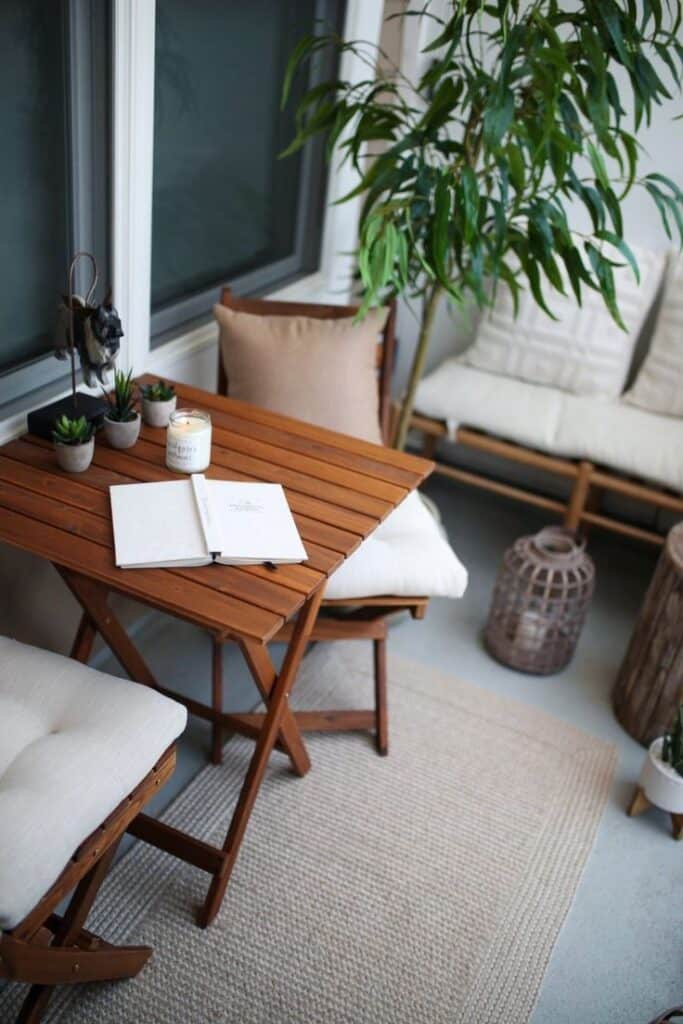
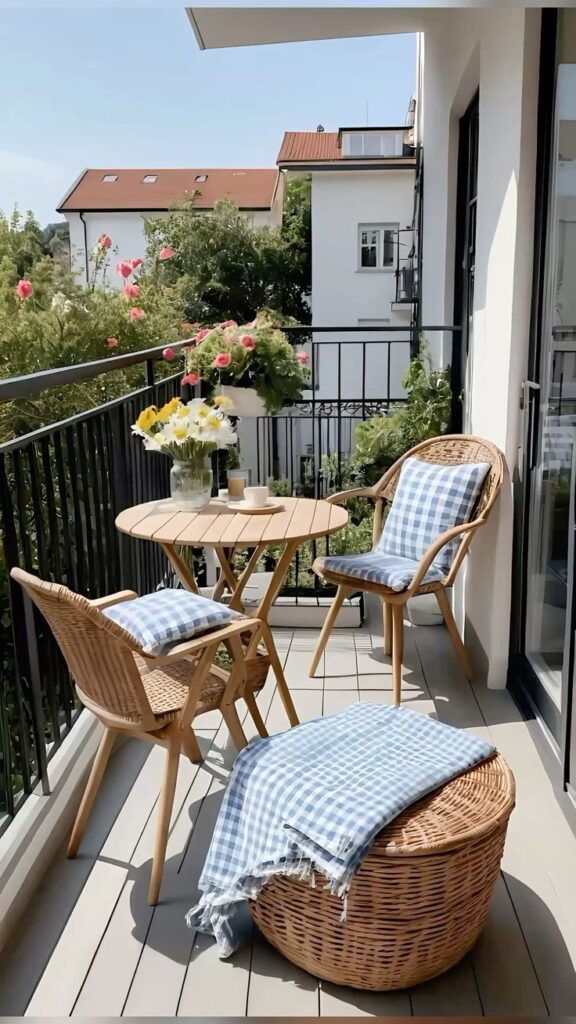
Furniture that serves more than one purpose is ideal for small balconies or terraces. Tables with built-in storage or seats that double as storage boxes maximize usability.
Convertible furniture, such as a bench that becomes a table, saves space and adds variety to uses. Small fold-out tables can be pulled out during meals and folded back when not needed.
Choosing lightweight furniture allows easy rearranging for different activities like dining or relaxing.
Arranging Furniture Layouts
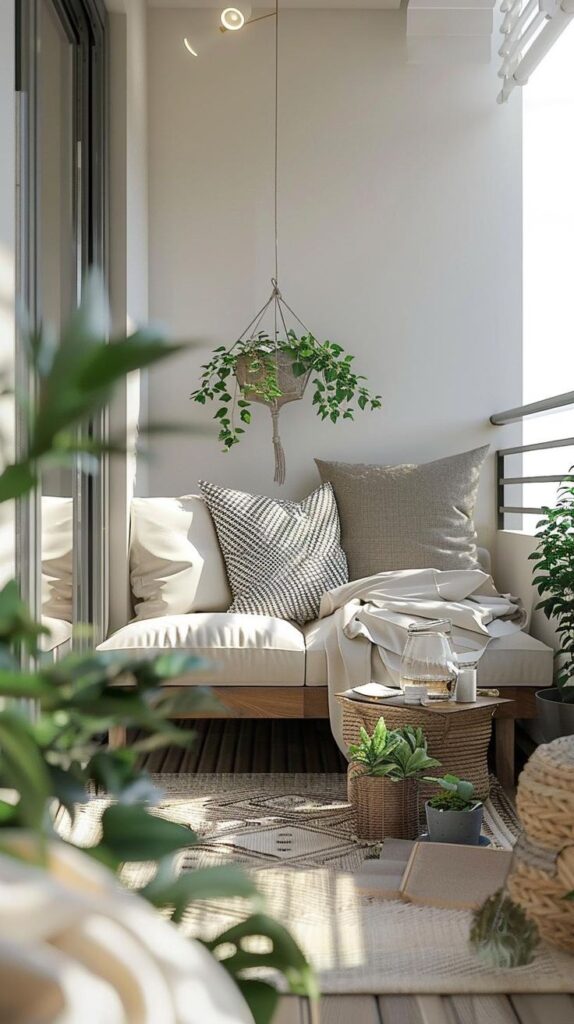
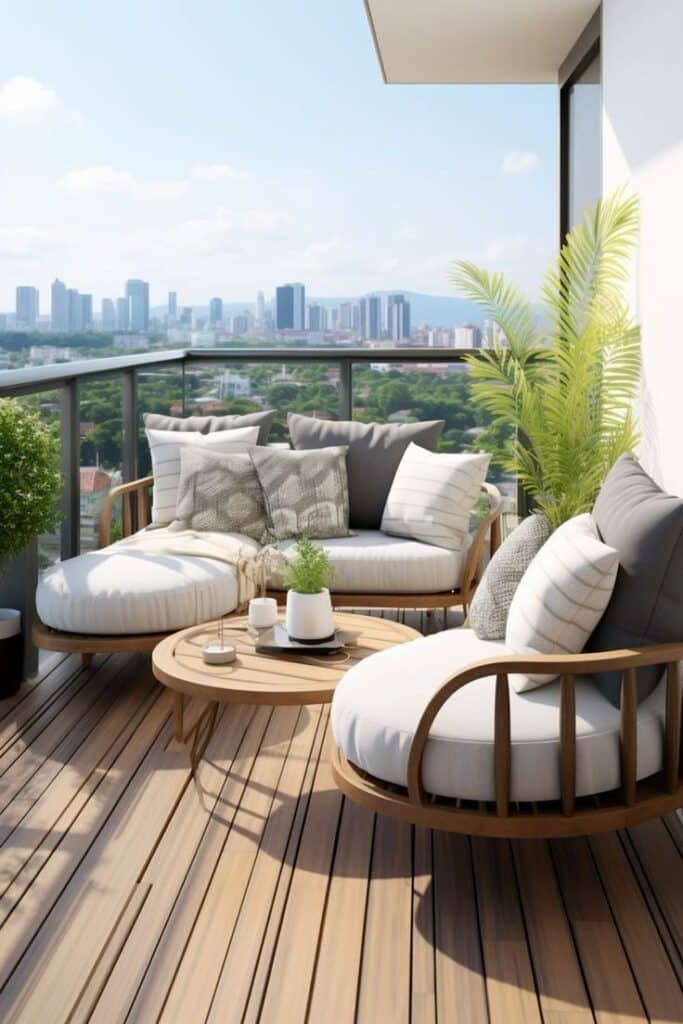
Arranging furniture to create open pathways helps a small space feel less crowded. Placing larger pieces against walls or corners frees central space for movement.
Grouping seating creates a cozy area without blocking access. Using vertical space by adding shelves or hanging planters keeps the floor clear.
Angles and positioning should prioritize functionality but can also enhance the overall look. Leave enough room between pieces to avoid a cramped feeling.
Color Schemes and Decor Themes
Choosing the right colors and decor styles can change the entire look of a balcony or terrace. Natural tones create a calm, earthy feel, while bold colors add energy and focus. Both approaches can be tailored to different types of outdoor spaces.
Incorporating Natural Hues
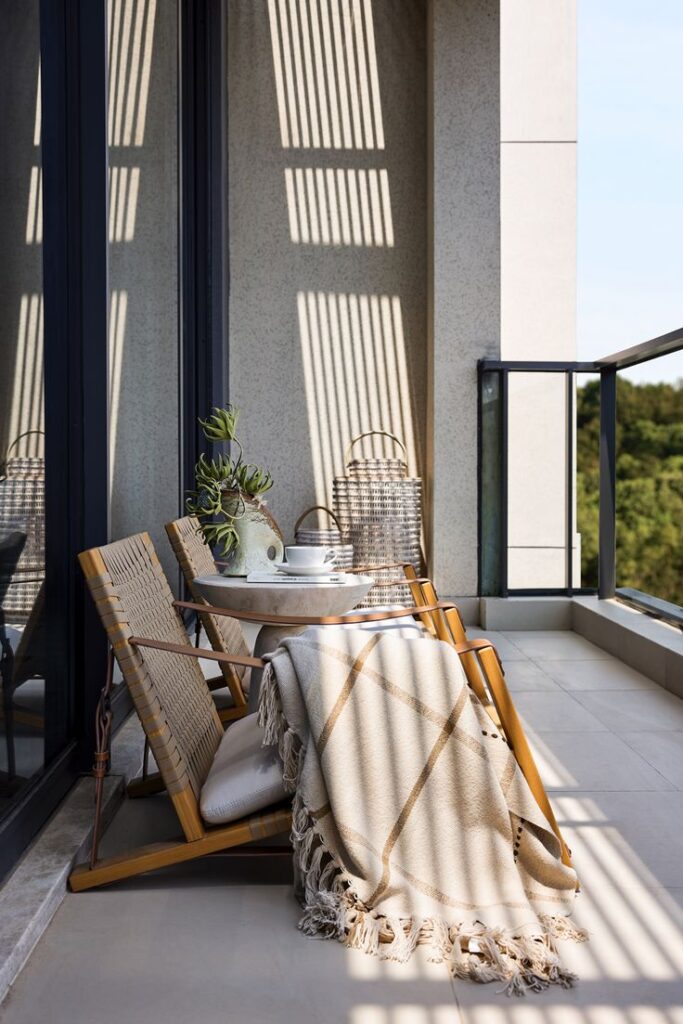
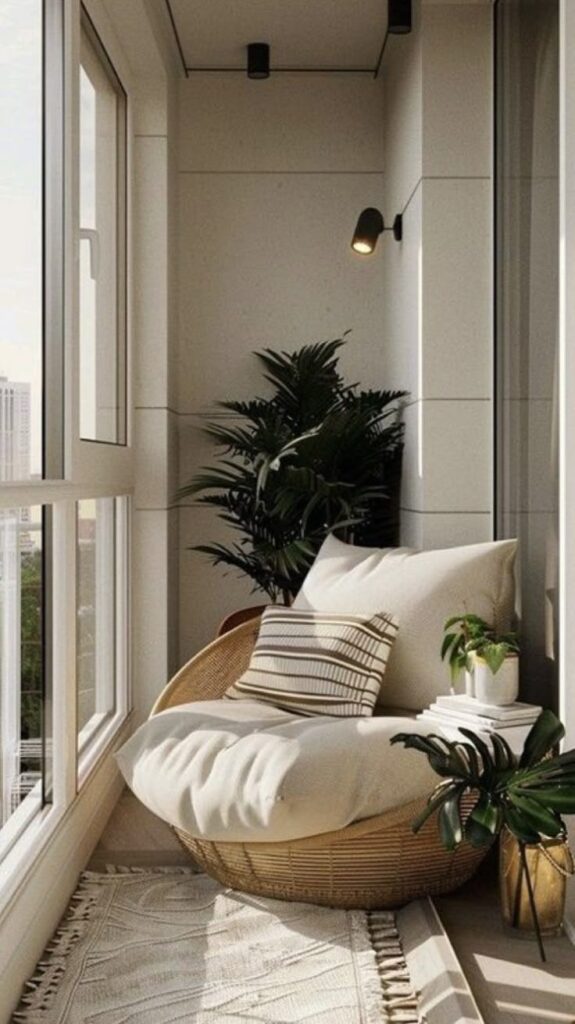
Natural hues like beige, soft greens, and browns blend well with outdoor environments. These colors help a space feel relaxing and connected to nature.
Wooden furniture in light or medium tones works well here. Additionally, plants with green leaves or small flowers enhance the natural look.
Using fabrics in cream, taupe, or sage for cushions and rugs adds softness without overpowering the space.
Tip: Stick to 2-3 natural colors to keep the look balanced and not too busy.
Bold Accent Colors
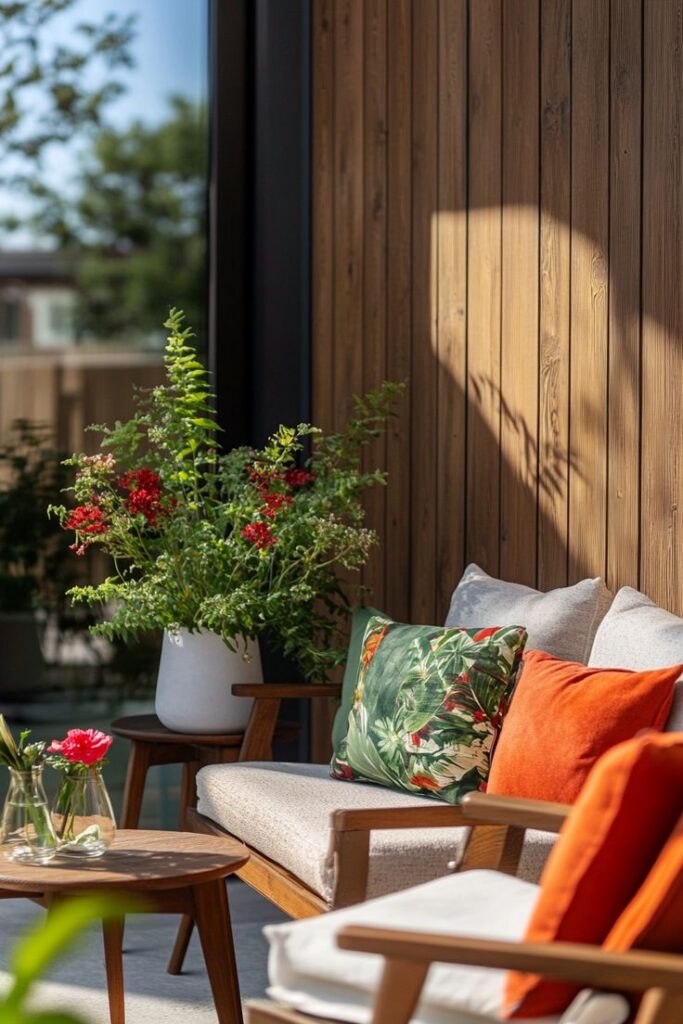
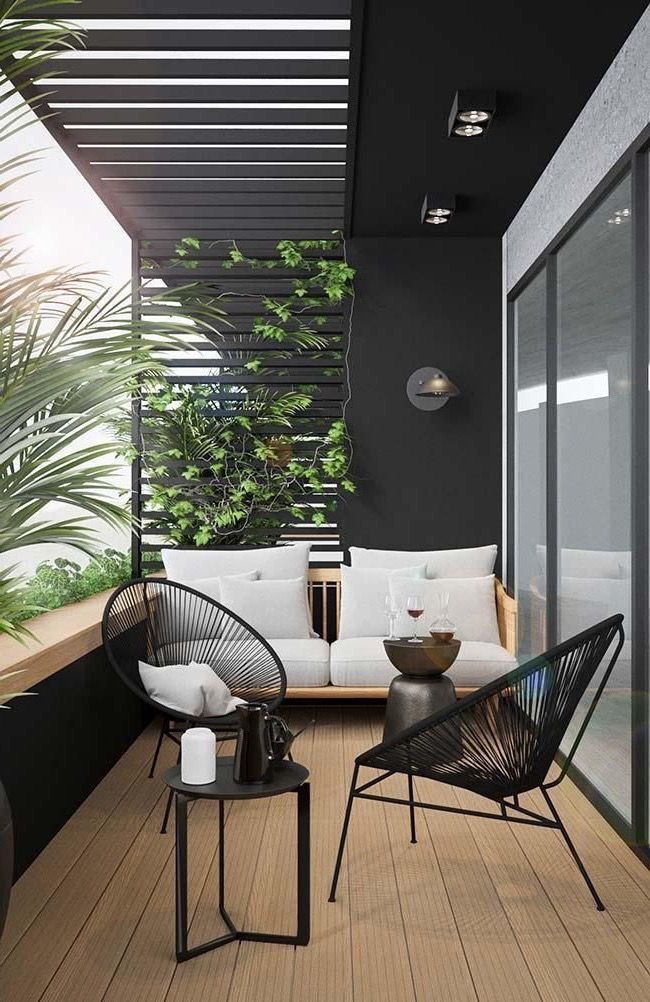
Bold accent colors make a terrace or balcony stand out. Bright blues, oranges, and reds can add energy and personality.
Accent pieces like throw pillows, outdoor rugs, or lanterns can introduce these colors without overwhelming the area.
One way to use bold colors is by matching them with neutral bases like gray or white. This combination keeps the space lively yet organized.
Example List of Bold Accents:
- Bright blue cushions
- Orange ceramic pots
- Red patterned rugs
Using bold colors in limited spots ensures the decor looks intentional and stylish.
Greenery and Outdoor Plants
Adding plants can bring life and color to any balcony or terrace. Using space smartly with vertical setups, picking easy-care species, and arranging pots well can make a big difference.
Vertical Gardening Methods
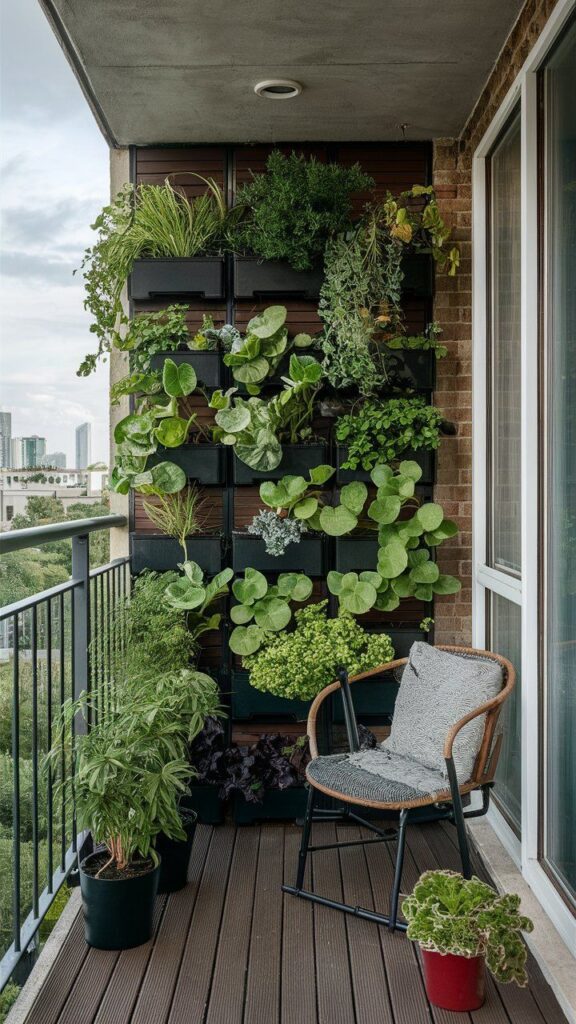
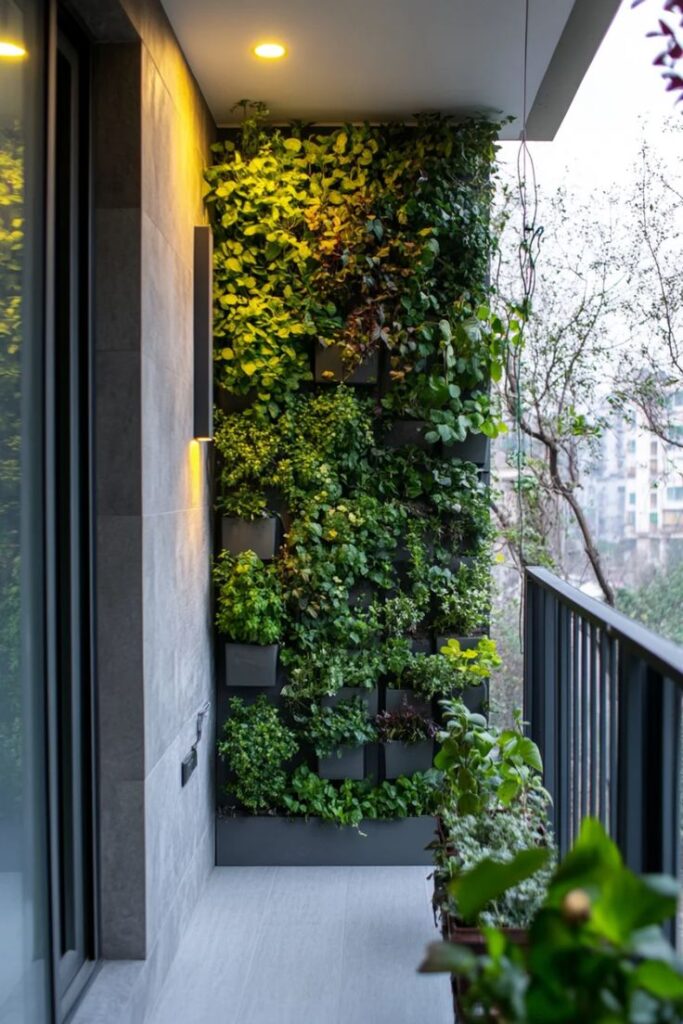
Vertical gardening saves floor space by using walls or railings. Hanging pockets, trellises, or stacked planters help grow plants upwards. This method works well for herbs, small flowers, and vines.
Using sturdy materials is important to hold weight safely. Mounting planters with proper hooks or brackets prevents accidents. Vertical gardens also improve privacy and add a natural backdrop.
Lighting and watering must be planned carefully. Plants higher up may need more sunlight and regular misting. Vertical gardens suit small areas and create a green feel without clutter.
Low-Maintenance Plant Choices
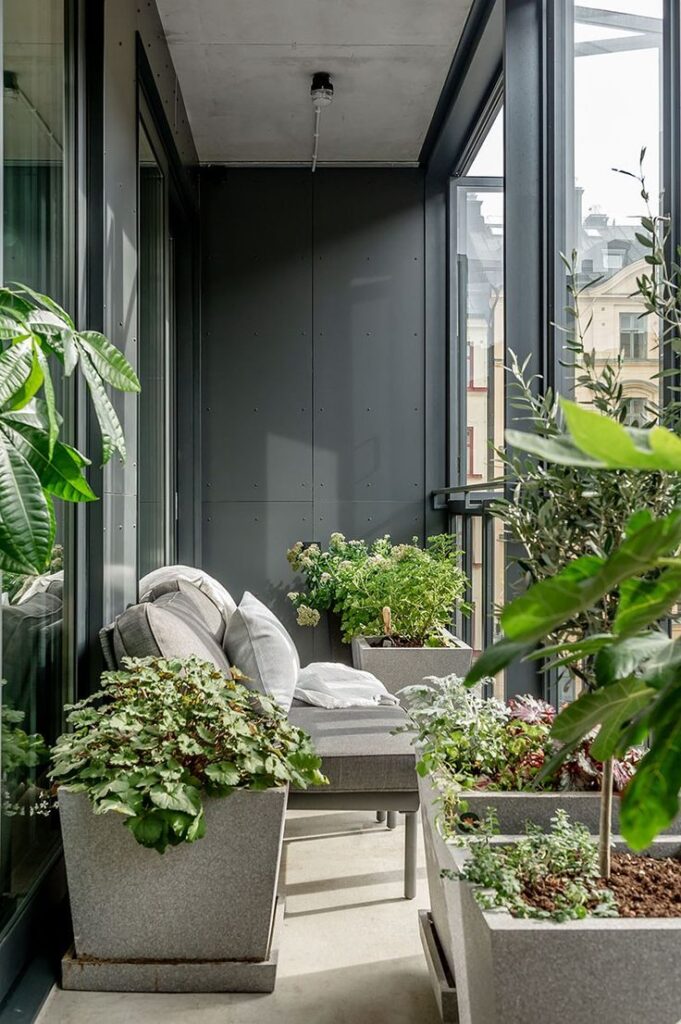
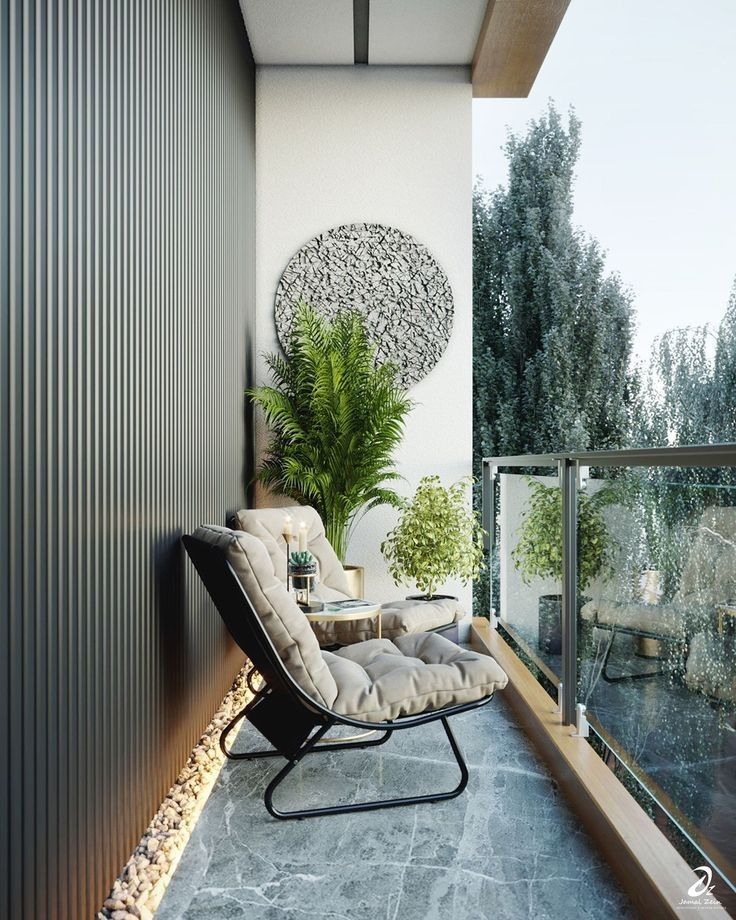
Choosing easy plants saves time and effort. Succulents, snake plants, and pothos need little water and handle different light levels. These plants work well for busy or new gardeners.
Herbs like rosemary and thyme also require minimal care and add fresh scents. Avoid plants that need daily attention or special soil. Drought-resistant plants are ideal for hot, sunny balconies.
Using low-maintenance species reduces the risk of dead or unhealthy plants. It keeps the space tidy and attractive all year. This choice supports a relaxed gardening routine.
Planters and Pot Arrangements
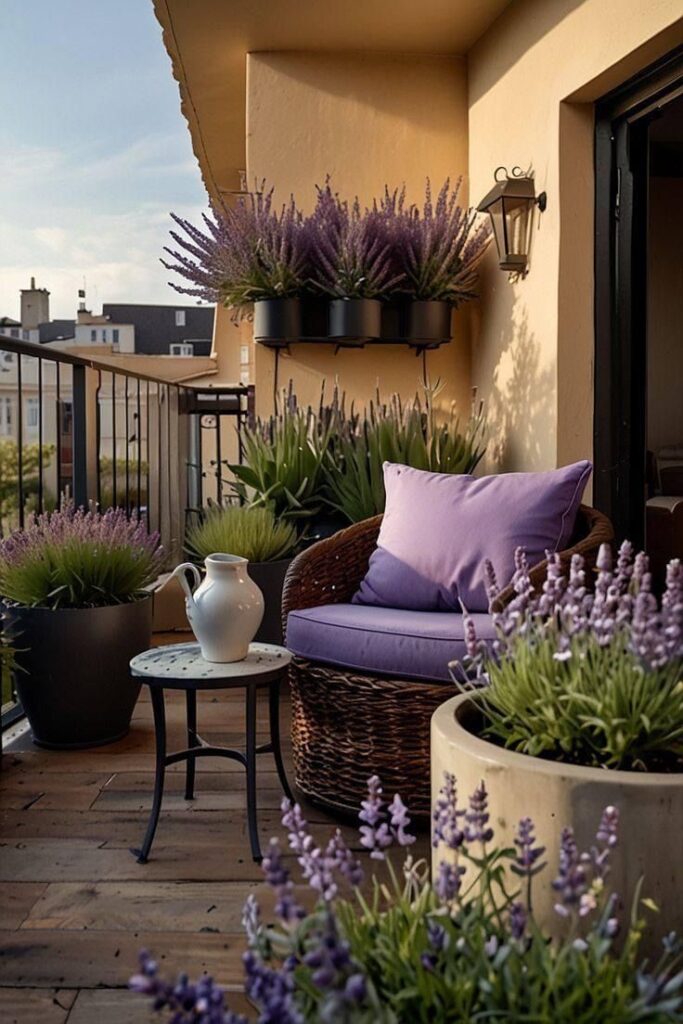
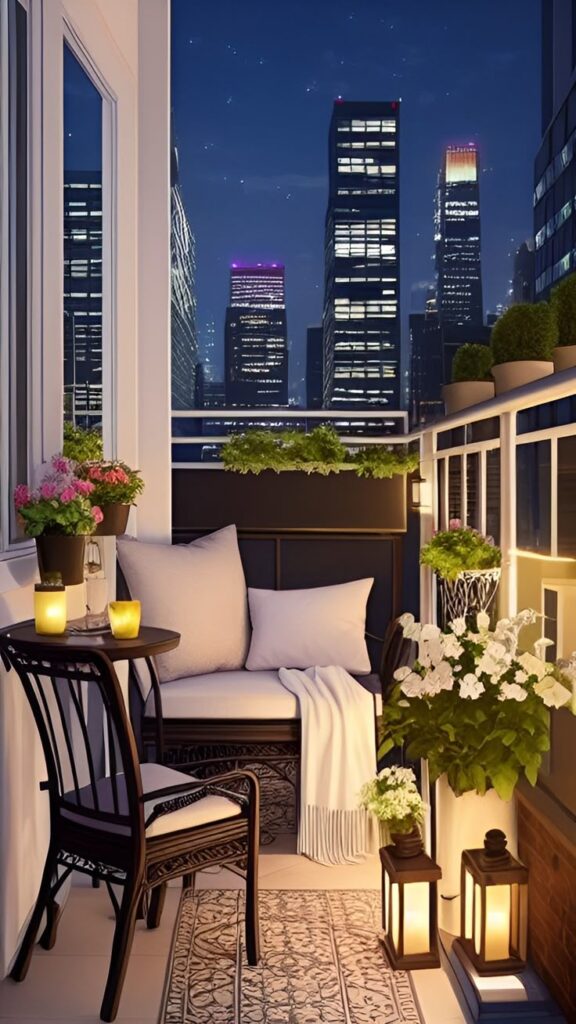
Using different sizes and shapes of planters adds style to the space. Combining tall pots with small ones creates layers and depth. Grouping pots by height or color gives a neat look.
Materials like ceramic, terracotta, and plastic each have pros and cons. Terracotta is porous and cools roots, while plastic is lightweight and cheaper. Choosing the right planter affects plant health and ease of moving them.
Drainage is key. Pots must have holes to prevent water build-up. Using trays underneath avoids water damage to the floor. Proper pot arrangement keeps plants healthy and the area organized.
Creative Lighting Solutions
Good lighting can transform a balcony or terrace. Choosing the right type helps create a cozy atmosphere and highlights key areas.
String Lights and Lanterns
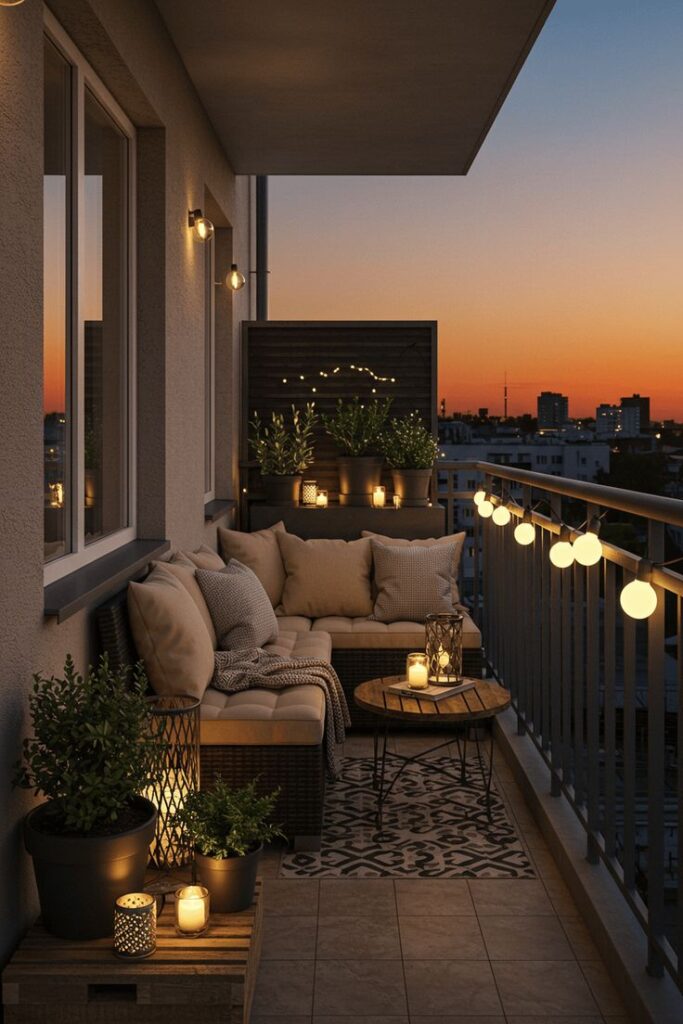
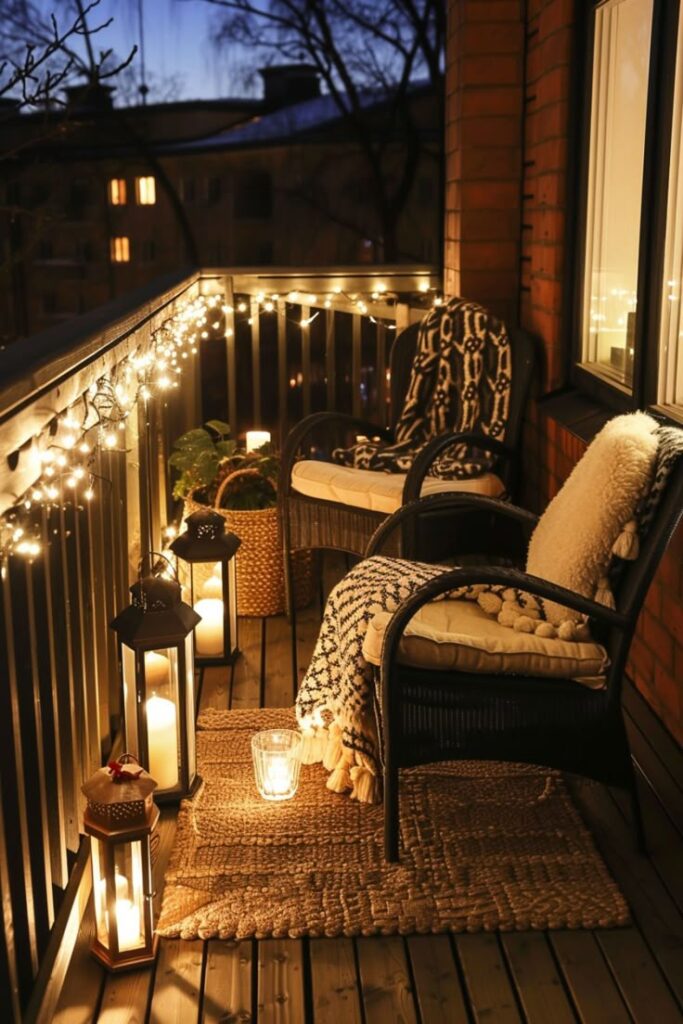
String lights are popular for adding soft, warm light. They are easy to hang around railings, ceilings, or plants. LED bulbs last long and use less power.
Lanterns come in many styles: hanging, tabletop, or floor. Battery-operated lanterns are safe and simple to use outdoors. Paper or metal lanterns add style and can fit different themes.
Both string lights and lanterns work well together. They can outline spaces or create a focal point, like a dining table or seating area. Using dimmers or timers can control the brightness and save energy.
Solar and LED Lighting Options
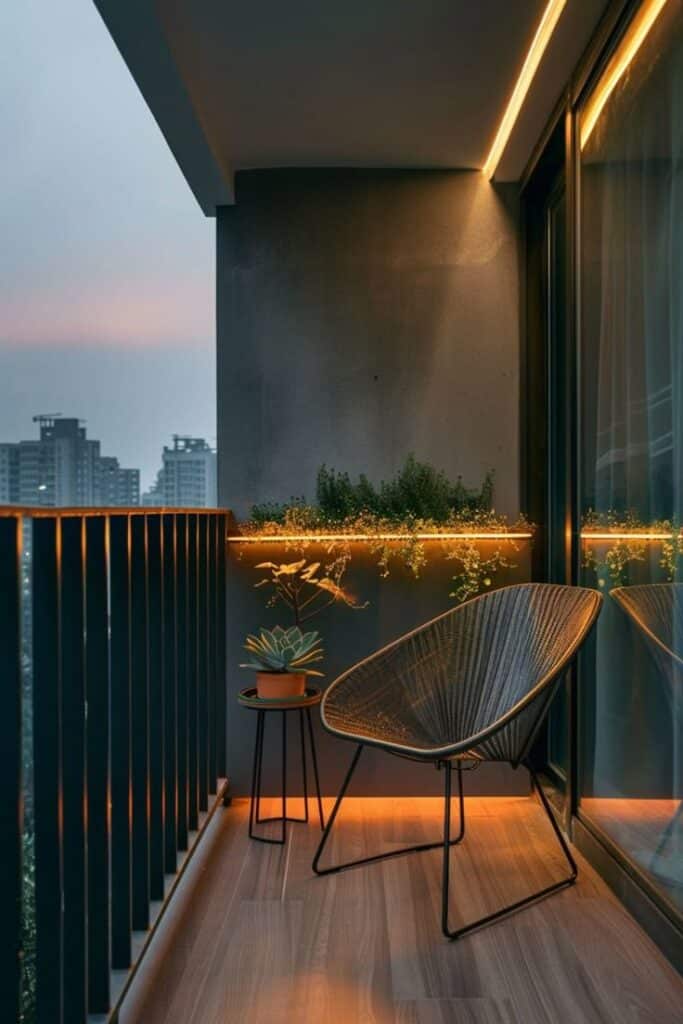
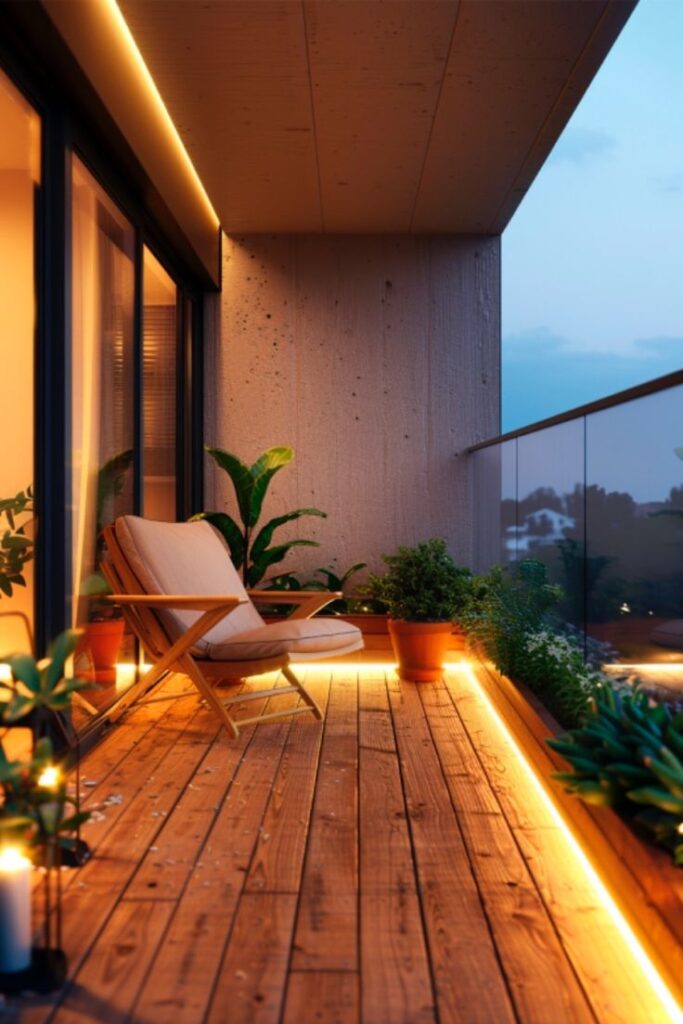
Solar lights charge during the day using sunlight. They are eco-friendly and need no wiring, making them easy to place anywhere. Solar stake lights work well in plant pots or garden beds on terraces.
LED lights are bright and energy-efficient. They come in strips, bulbs, and spotlights. LED strips can be attached under railings or shelves for subtle illumination. Spotlights highlight plants or art pieces.
Both solar and LED options reduce electricity use. Choosing waterproof versions ensures durability in outdoor environments. Mixing these lights creates layers of brightness for comfort and function.
Privacy and Shade Features
Balconies and terraces benefit from features that create both privacy and shade. These help make outdoor spaces more comfortable and usable at different times of the day. Options include fixed and movable solutions to control sunlight and block views from neighbors.
Privacy Screens and Panels
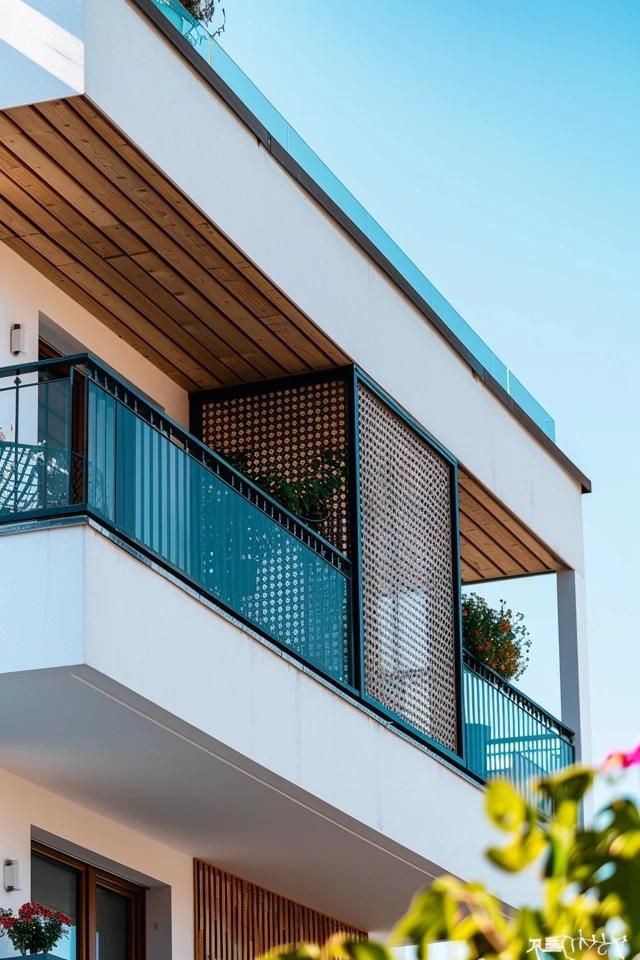

Privacy screens come in many materials like wood, metal, or bamboo. They serve as barriers that block the view from outside while adding style. Some screens are decorative with cut-out patterns, which allow airflow but still provide coverage.
Screens can be freestanding or attached to existing structures. Trellis panels support climbing plants, adding a natural element while boosting privacy. It’s important to choose screens that fit the balcony size and style.
Outdoor Curtains and Blinds
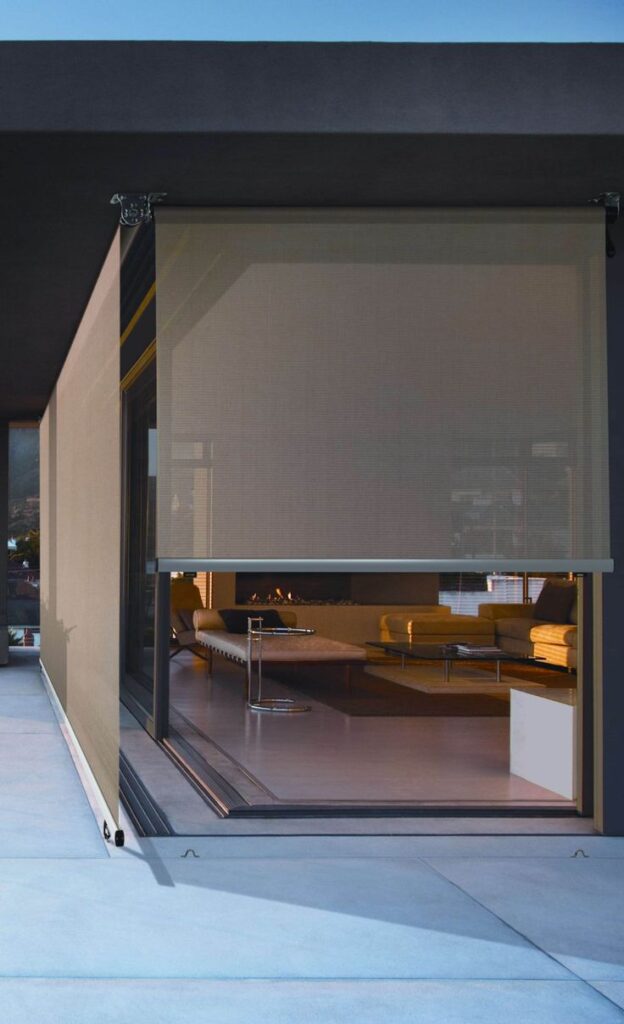
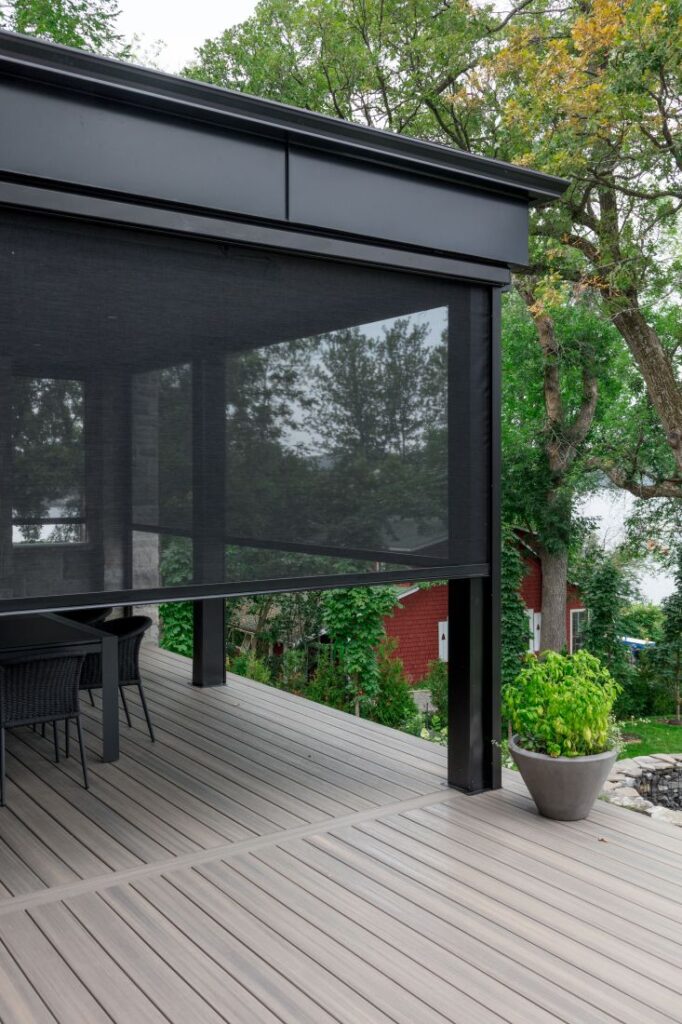
Outdoor curtains use weather-resistant fabrics designed to handle sun, rain, and wind. They can be drawn open or closed for flexible privacy and shade control. Curtains soften the look of a balcony while providing a cozy feel.
Blinds are another option, often made from bamboo or PVC. They roll up or down easily and protect against sun glare. Both curtains and blinds can be mounted on rails or rods for smooth movement.
Textiles and Comfort Elements
Balconies and terraces benefit from textiles that add softness and style while withstanding outdoor conditions. Choosing the right materials ensures comfort and durability, creating a pleasant space to relax.
Weather-Resistant Rugs
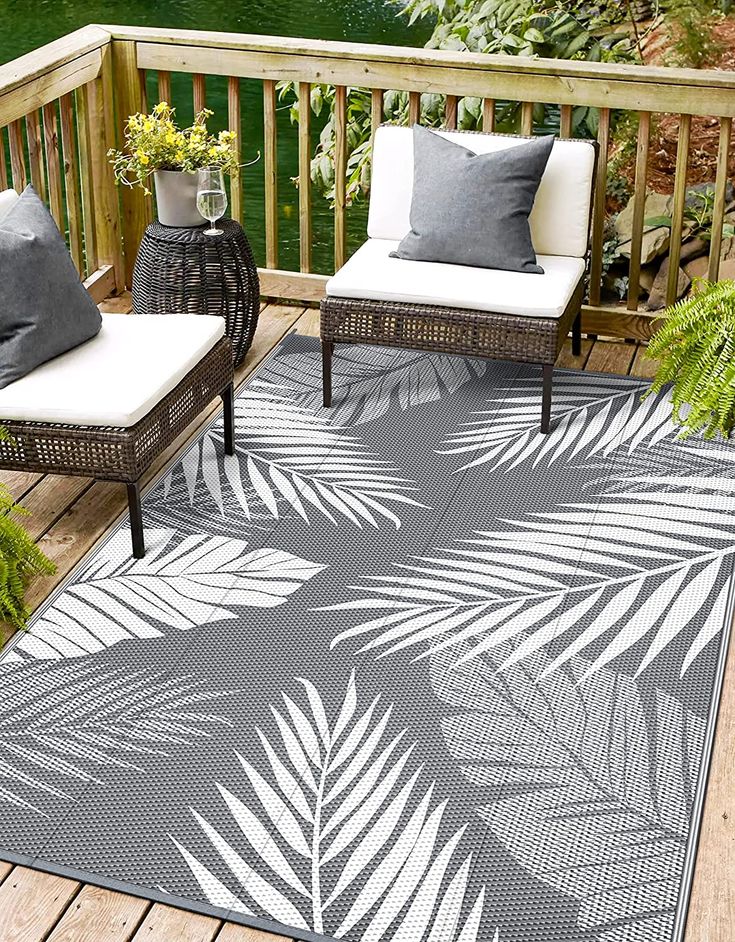
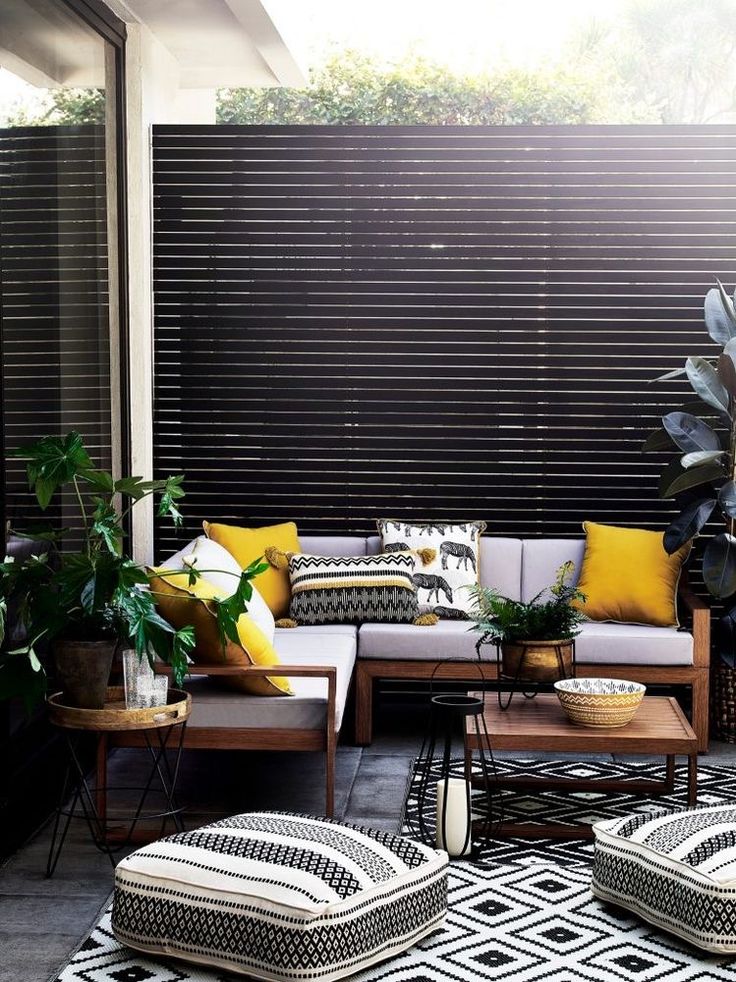
Weather-resistant rugs are designed to handle sun, rain, and dirt. They use synthetic fibers like polypropylene or polyester, which do not absorb water easily and dry quickly. These rugs prevent mold and mildew, making them practical for outdoor use.
When selecting a rug, consider size and color. A larger rug can define the seating area, while patterns can add visual interest. Rugs often come with non-slip backing, which is important for safety on smooth balcony floors.
Cleaning is simple. Most weather-resistant rugs can be shaken out or washed with mild soap and water. This low maintenance keeps the space looking fresh over time.
Cushions and Throws
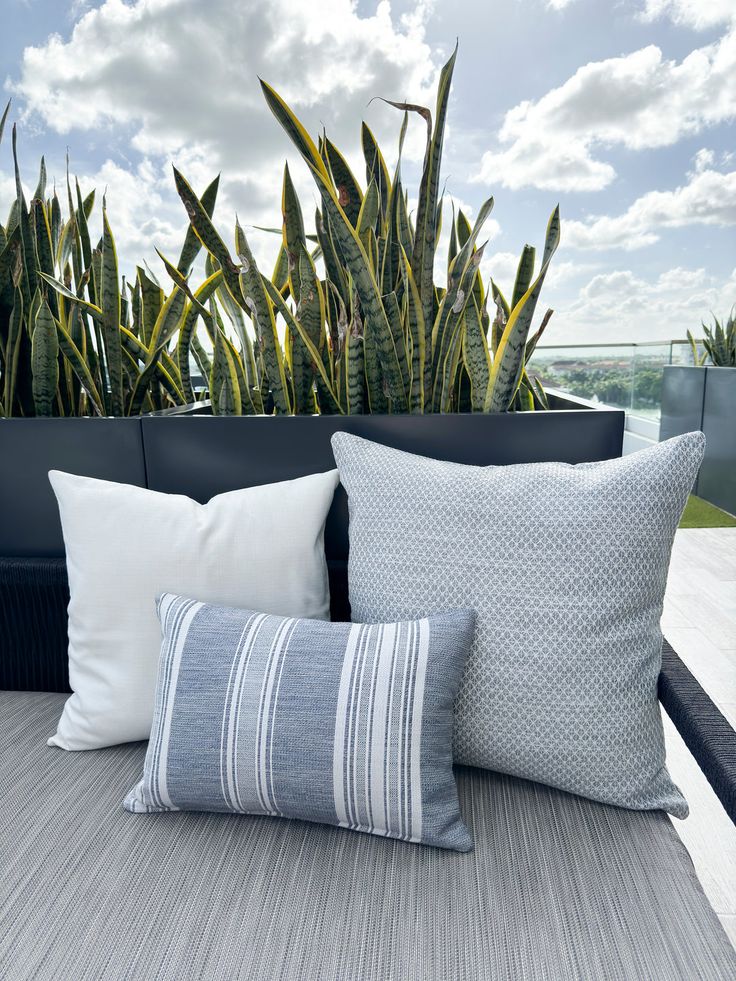
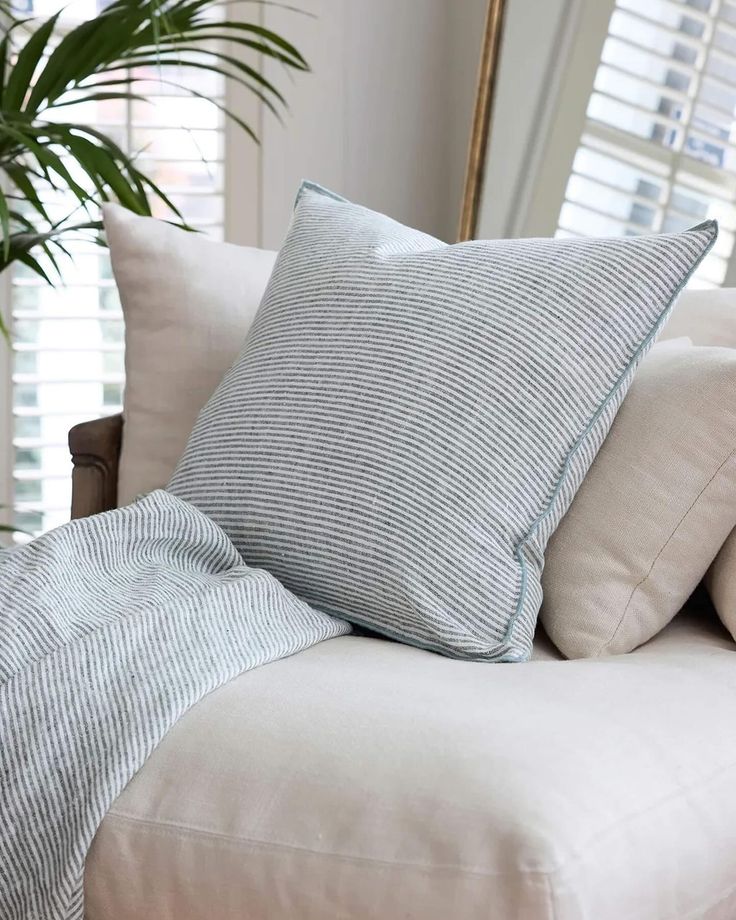
Cushions and throws boost comfort and add color to balcony furniture. Outdoor cushions should have covers made of water-resistant and UV-protected fabric like Sunbrella or acrylic. These fabrics resist fading and prevent damage from rain or sun.
It is best to choose cushions with removable covers for easy cleaning. Throws add warmth and a cozy feel for cooler evenings. They should be lightweight and quick-drying.
Using a mix of sizes and textures creates an inviting atmosphere. Solid colors can balance bold patterns and vice versa. Storing cushions in waterproof containers when not in use helps extend their life.
Dining and Entertainment Zones
Creating a space for eating and socializing is key for balcony or terrace use. Choosing the right furniture and appliances helps make these areas comfortable and functional.
Compact Dining Sets
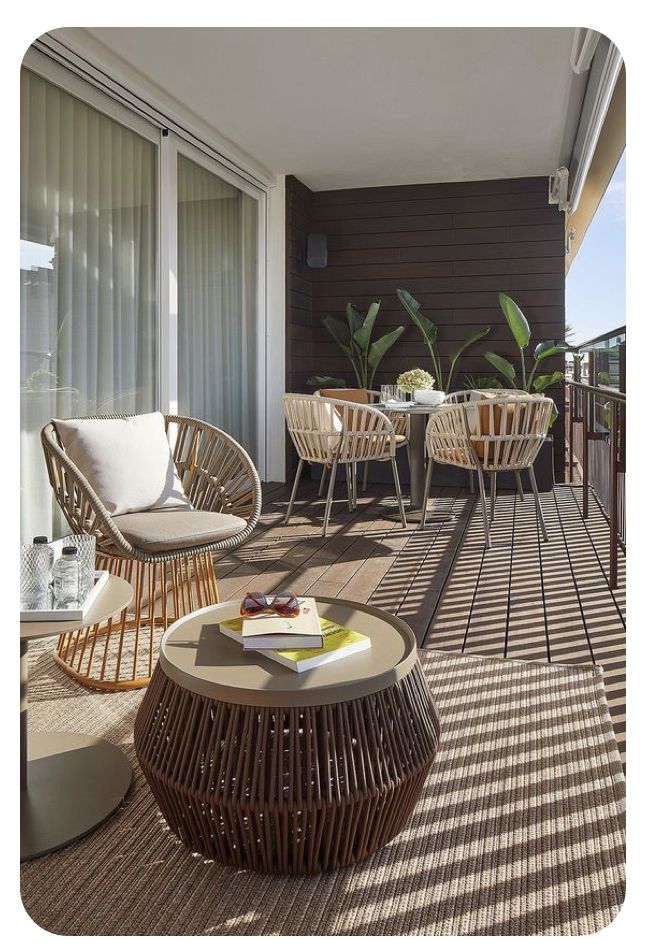
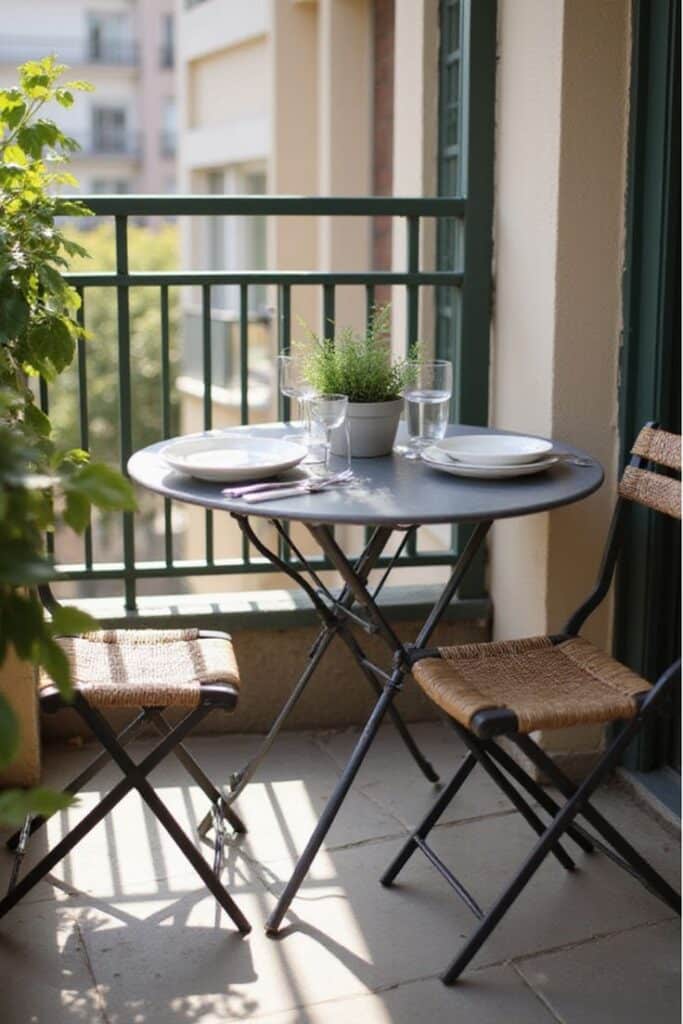
A compact dining set fits well in small spaces while providing enough seating. Folding tables and stackable chairs save room when not in use. Round or square tables with slim legs allow easier movement around the area.
Materials like metal or weather-resistant wood ensure durability outside. Cushioned seats add comfort without taking up much space. Some sets include storage within the table or seats, which is helpful for keeping accessories nearby.
Choosing a set with simple design maintains a clean look. It also allows adding personal touches like tablecloths or small plants for decoration.
Outdoor Cooking Appliances
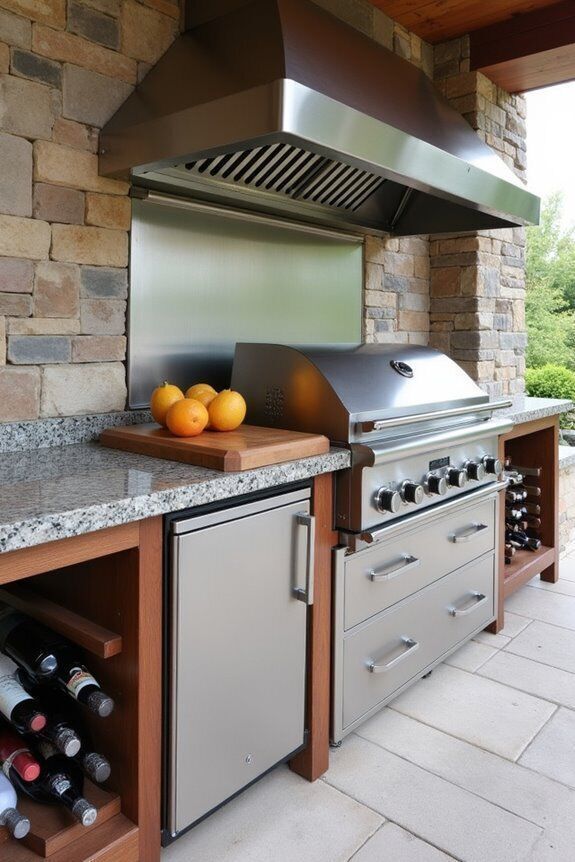
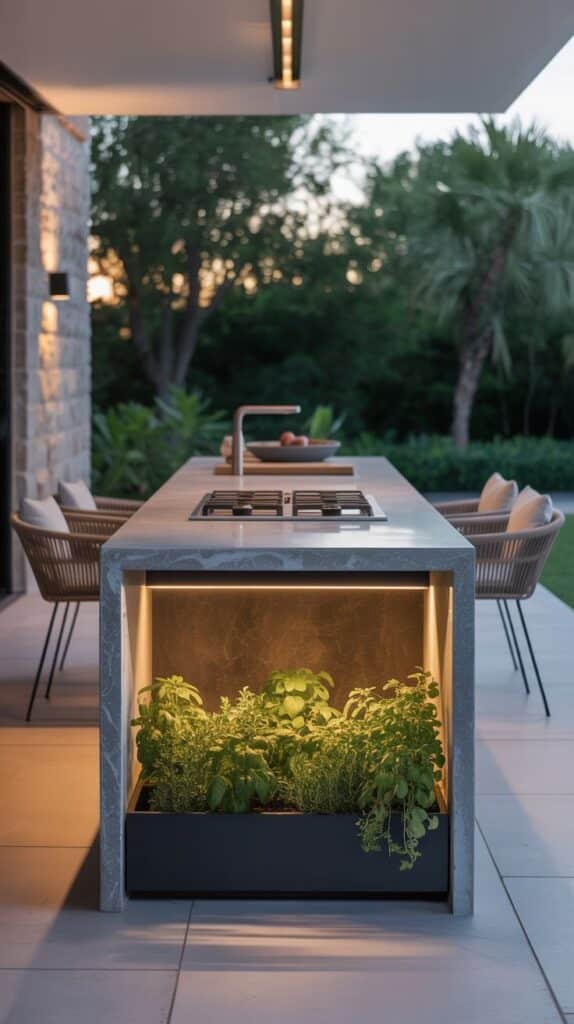
Outdoor grills and cooktops turn the balcony or terrace into an entertainment spot. Small electric grills or portable gas stoves are suited for limited space and easy setup. Some models include safety features for secure use on balconies.
Built-in grills require professional installation but offer a permanent cooking area. They save countertop space and can increase property value.
Smokeless or low-smoke appliances reduce disturbance to neighbors. Adding a compact prep table or rolling cart provides surface area for cooking tools and ingredients.
Personal Touches and Decorative Accents
Adding personal items and changing accents regularly can make a balcony or terrace feel more comfortable and stylish. Using art or seasonal items gives a unique look that reflects individual tastes and suits different times of the year.
Art Pieces and Sculptures
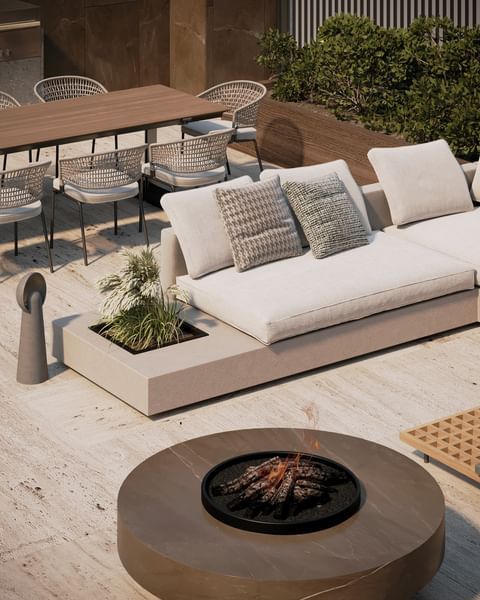
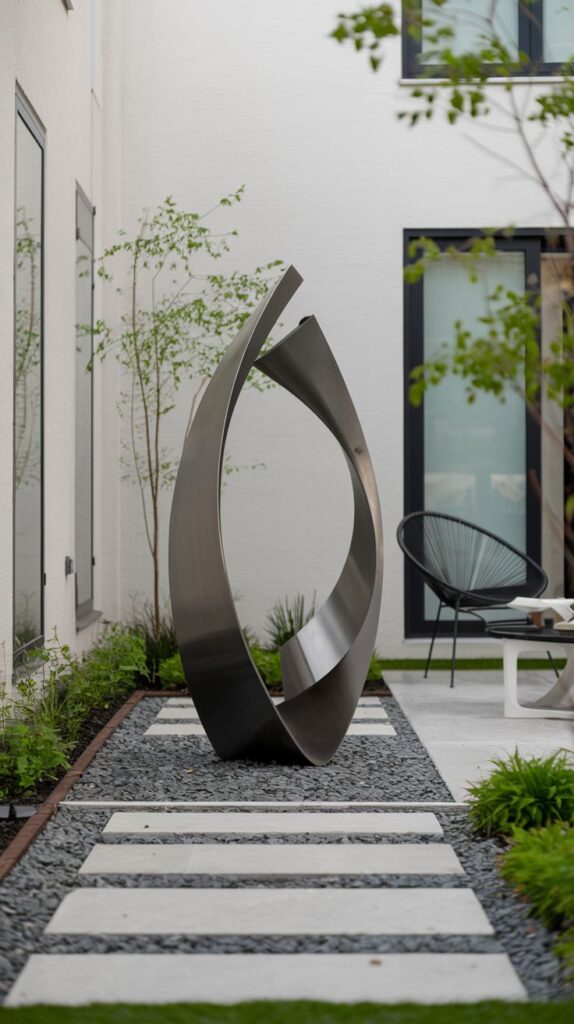
Small sculptures or wall art add personality to outdoor spaces. Durable materials like metal, stone, or weather-resistant resin work best for outside use.
Choosing pieces that reflect personal interests—like abstract shapes, animals, or natural themes—makes decoration more meaningful. Hanging wall art frees up floor space while sculptures placed on tables or corners create focal points.
Grouping items of different sizes can add depth and interest. The key is to avoid overcrowding to keep a neat, balanced look.
Seasonal Decor Updates

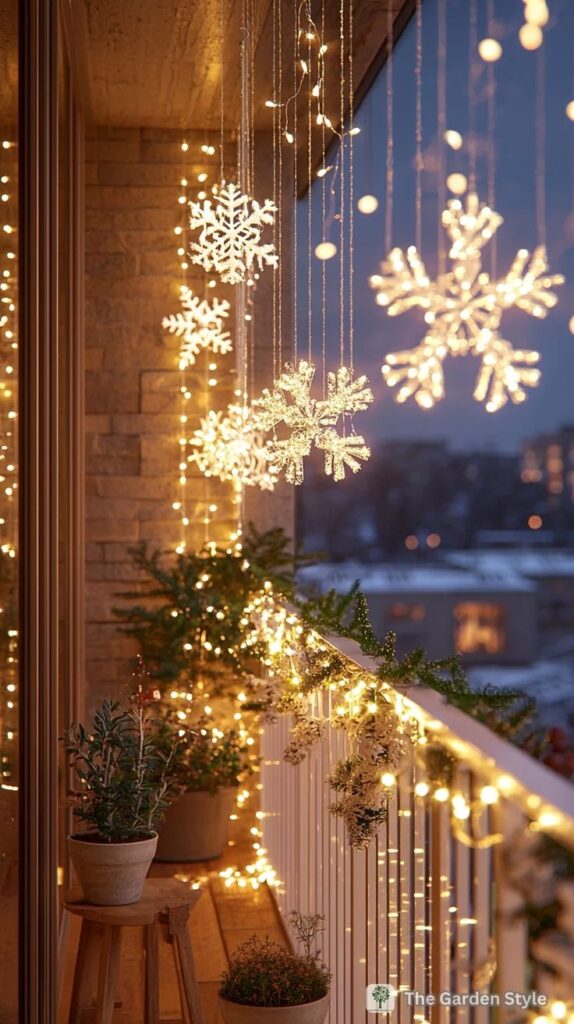
Changing decor with the seasons keeps the space fresh. For spring, light fabrics and floral accents bring brightness. In summer, use vibrant colors and lanterns for warm evenings.
Fall calls for earth tones and cozy textiles like throw blankets. Winter decor can include string lights, pine cones, or small evergreen plants for a festive mood.
A simple storage solution helps swap items quickly without clutter. Rotating pieces prevents the area from feeling stale while staying practical and inviting.
Maintenance and Practical Considerations
Balconies and terraces need regular care to stay safe and attractive. Protecting them from weather damage and choosing easy-to-clean materials can save time and money.
Weather Protection Tips
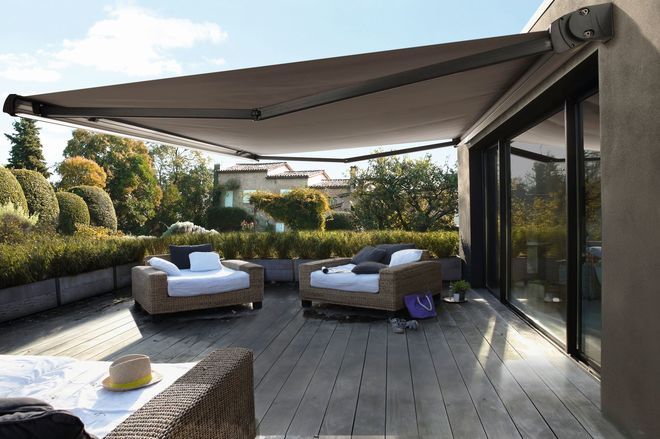
Weather can quickly damage balcony furniture and floors. Using waterproof covers or storing cushions indoors during rain will keep them in good condition longer.
Installing a retractable awning or shade sail can protect the area from sun and rain without blocking the view. Make sure the roof or overhead cover drains water well to avoid puddles and damage.
Metal furniture should be checked for rust regularly. Applying a rust-resistant spray every few months helps. Wooden furniture benefits from sealants that prevent water absorption and cracks.
Easy-Clean Solutions
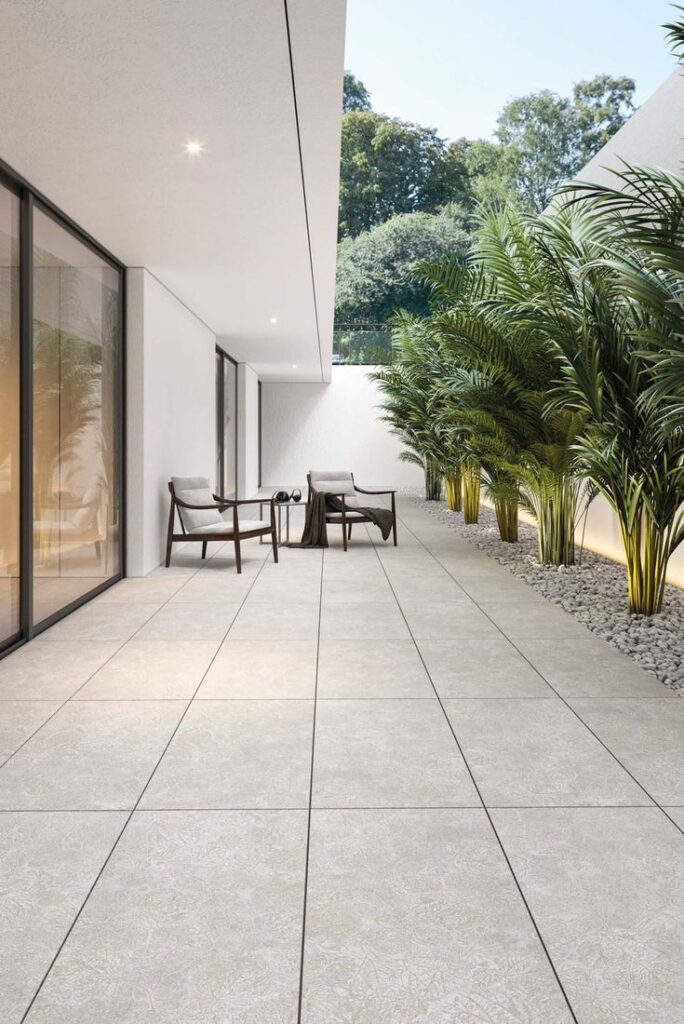
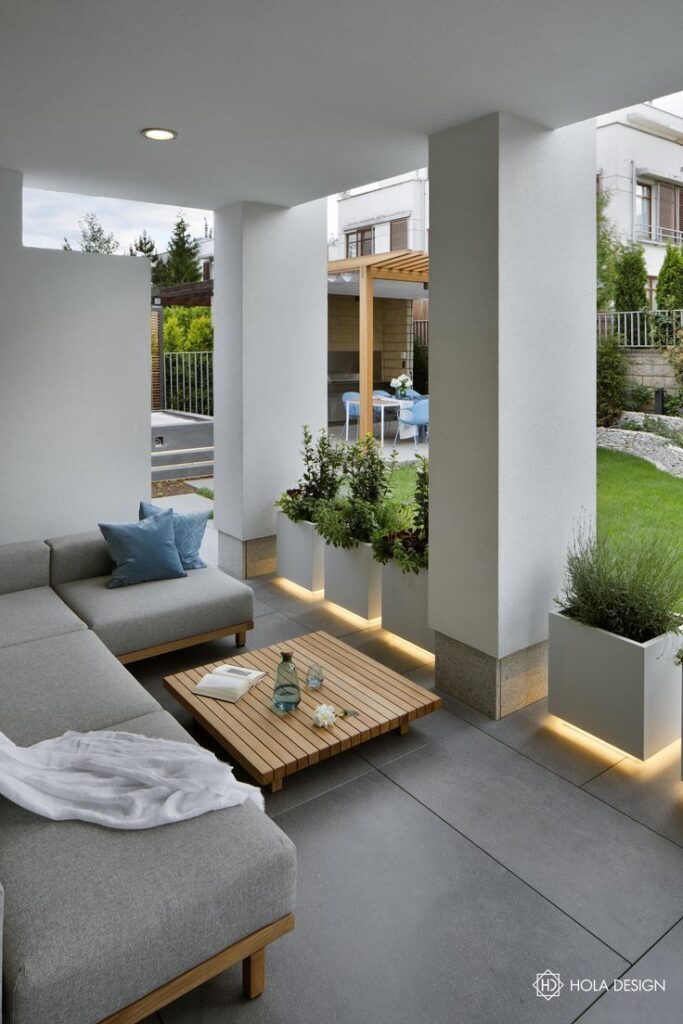
Choosing materials that resist dirt and stains makes cleaning simpler. For floors, porcelain tiles or composite decking usually require less effort than natural stone or wood.
Using removable, washable cushion covers and outdoor rugs can reduce maintenance. Spot clean spills immediately to prevent stains from setting in.
A small handheld vacuum or broom helps keep leaves and debris off. Regular wiping of furniture with mild soap and water prevents buildup of grime and mold.
- 0shares
- Facebook0
- Pinterest0
- Twitter0

